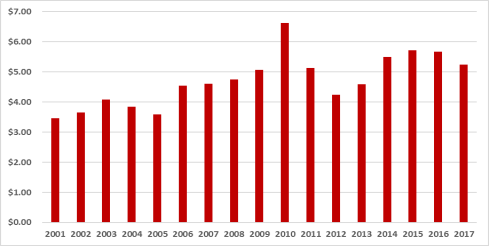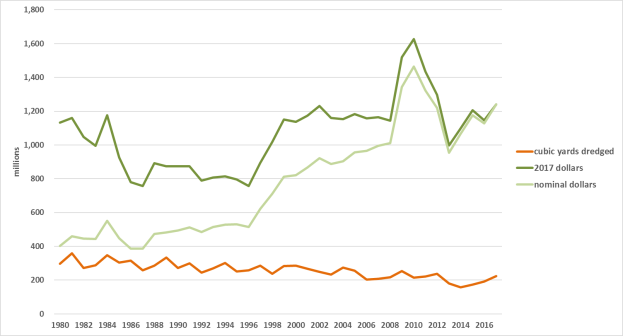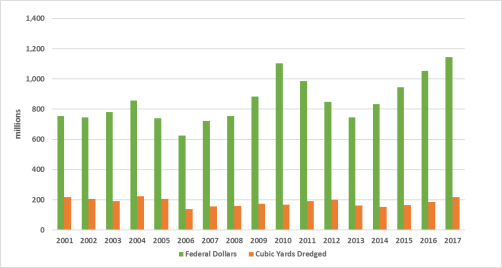Congress is debating whether to support increased funding for dredging to better maintain harbor channel depths and widths. A bill approved by the House Transportation and Infrastructure Committee (H.R. 2440) seeks to boost dredging activity by utilizing more of the collections from a port tax levied to fund harbor maintenance. However, it is not clear how the additional funding would change the volume of material dredged from U.S. harbors, as limits on the U.S. dredge fleet and environmental restrictions on when dredging can be performed, among other factors, affect the cost and performance of harbor dredging.
Data from the U.S. Army Corps of Engineers (USACE), the agency responsible for federal harbor maintenance, reveal that an increase in inflation-adjusted spending on routine maintenance dredging from 2001 to 2017 was not matched by an increase in the amount of material dredged (Figure 1). Over the five-year period from 2013 to 2017, spending on routine maintenance dredging was 22% higher (adjusted for inflation) than during the 2001-2005 period, but the actual amount of material dredged was 15% less. These data cover only routine dredging to maintain navigation channel depths and widths, excluding unplanned work such as dredging after hurricanes, which typically costs more. New construction dredging to expand shipping channels beyond existing authorized dimensions, which also is typically more costly than maintenance dredging, is also excluded from the data.
Looked at another way (Figure 2), the average annual cost per cubic yard of dredged material for regular harbor maintenance, adjusted for inflation, has risen from $3.46 in 2001 to $5.24 in 2017, an increase of 51% from 2001.
|
Figure 2. Cost Per Cubic Yard for "Regular" Harbor Maintenance Dredging
(2017 dollars)
|
 |
|
Source: CRS, using data from USACE, Dredging Cost Analysis.
|
When including all maintenance dredging (i.e., unplanned work) and new construction dredging, USACE data show (Figure 3) a declining trend in the amount of material dredged since 1980 despite increases in federal funding.
|
Figure 3. All Maintenance and New Work Dredging
|
 |
|
Source: CRS, using data from USACE personal communication, June 8, 2019.
Note: 2017 dollars calculated using "nondefense" deflator, Table 10.1 in Federal Budget.
|
Multiple factors are believed to be causing recent cost increases—changes in dredged material disposal, mobilization costs, cost inflation of inputs, environmental factors, and a shortage of dredging firms—but the relative significance of each is unknown. Old disposal sites can be full and newer ones more distant. Unknown is whether enactment of P.L. 104-303 in 1996 led to more federal dollars being used to build and maintain disposal facilities, treat contaminated sediments, or transport dredge spoils further for beneficial uses. Mobilization and demobilization of the several vessels typically required for a dredge project can be more than one-third of project cost in the United States. In addition to changes in the cost of fuel, steel, and labor (accounted for in Figure 1 and Figure 2 above by inflation adjustments), cost of dredged material disposal and compliance with environmental protection requirements may be increasing. For example, to protect endangered species such as sea turtles, dredging firms might have to employ fishing trawlers or restrict dredging and spoils disposal to winter months when bad weather raises costs. Table 1 shows wide variation among USACE districts in the unit cost of dredging.
Table 1. Average Unit Cost of Dredging by Selected USACE District
Contracts >100,000 cubic yards, 2014 to 2018
|
USACE District
|
Cubic Yards Dredged
|
Cost per Cubic Yard
|
|
San Francisco
|
5,398,939
|
$ 24.27
|
|
New York
|
11,908,916
|
$ 23.17
|
|
Philadelphia
|
6,037,757
|
$ 19.93
|
|
Jacksonville
|
22,447,059
|
$ 14.86
|
|
Los Angeles
|
1,283,153
|
$ 13.20
|
|
Detroit
|
3,064,310
|
$ 9.40
|
|
Alaska
|
5,550,057
|
$ 8.58
|
|
Savannah
|
37,140,202
|
$ 6.52
|
|
Portland (OR)
|
30,983,332
|
$ 5.29
|
|
Galveston
|
76,646,189
|
$ 3.80
|
|
New Orleans
|
105,894,803
|
$ 2.62
|
Congress, per 33 U.S.C. §622, has directed the USACE to contract out dredging work to private firms whenever possible. A handful of firms bid for USACE dredging projects; foreign firms and foreign-built dredges are prohibited in U.S. waters. USACE dredging contract data indicate that of the 701 dredging contracts the agency awarded from 2014 to 2018, 295 (42%) were sole-bid contracts and 178 (25%) attracted two bidders.
Hopper dredges are generally preferred for dredging coastal harbors because they can work in rough water and can more efficiently transport dredge spoils to disposal sites. The four U.S. firms that own the 15 hopper dredges in the U.S. fleet accounted for 59% of the USACE's dredging contracts awarded in dollar value and 32% of the total number of contracts awarded from 2014 to 2018. The USACE owns four hopper dredges employed for emergency work or when private industry submits bids much higher than the USACE's estimated cost. In 1978 (P.L. 95-269), Congress reduced the USACE-owned fleet in hopes of increasing the private fleet and competition among dredging firms.
The USACE is unable at times to schedule as much dredging as desired due to a lack of dredges. Compared to the fleets of the four European dredging firms considered world leaders, the U.S. fleet of hopper vessels is smaller and older. Each of the four European firms has a hopper fleet whose capacity is three to four times that of the entire U.S. fleet. According to an advocate for foreign investors in the United States, European dredging firms "could complete the U.S. projects for half the estimated cost and a third of the time." One analysis finds dredging costs have trended downward in foreign markets. Foreign firms use heavy-lift ships to transport their dredge fleets. U.S. dredging firms would be required by law to use a U.S.-built heavy-lift ship for transport, but none exist; U.S. firms therefore tow individual vessels to jobsites and stage equipment in various coastal locations.


